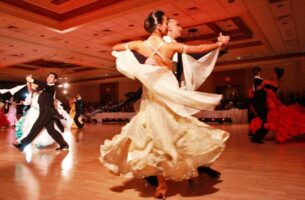Dansclassicballroom.com is a premier website dedicated to all things related to ballroom dancing in the United States. With a mission to promote and preserve the art of ballroom dance, this online platform has become a go-to resource for dancers of all skill levels, enthusiasts, and those curious to explore the captivating world of ballroom dance […]
Read MoreBallroom dancing in the United States has a rich and vibrant history that stretches back to the early 20th century. With its roots in European dance traditions, ballroom dancing has evolved into a captivating art form celebrated across the nation. From the glitz and glamour of competitive events to the social dance scenes in local communities, ballroom dancing has carved out a special place in American culture.
The Early Years: A Fusion of Styles
In the early 1900s, ballroom dancing made its way to the USA through the influences of immigrants who brought their dance traditions from Europe. These early dance forms, such as the waltz, tango, and foxtrot, quickly gained popularity in American social circles. The dance halls and ballrooms of New York, Los Angeles, and other major cities became the breeding grounds for the spread of this captivating art.
The Golden Age: Hollywood and Ballroom Dancing
Ballroom dancing in the USA reached its pinnacle of popularity during the Golden Age of Hollywood in the 1930s and 1940s. Iconic dance duos like Fred Astaire and Ginger Rogers showcased their remarkable talents, capturing the hearts of millions of Americans. Films like “Top Hat” and “Swing Time” inspired people to take up ballroom dancing and embrace its elegance and charm.
The Rise of Competitions
In the mid-20th century, ballroom dance competitions began to take center stage. These events, often featuring dazzling costumes and stunning choreography, allowed dancers to showcase their skills and artistry. The United States Dance Championships, held annually in various cities, became one of the most prestigious competitions in the country. Dancers from all walks of life aspired to participate and make a name for themselves in the ballroom dance community.
The Influence of TV Shows and Pop Culture
The 21st century brought renewed interest in ballroom dancing, thanks in part to popular TV shows like “Dancing with the Stars.” This reality competition show pitted celebrities against professional ballroom dancers, attracting a massive viewership and reigniting the public’s fascination with ballroom dance. As a result, more and more Americans began seeking out dance studios to learn various ballroom styles, further spreading the love for this captivating dance form.
Styles of Ballroom Dancing in the USA
The ballroom dance scene in the USA boasts a diverse range of styles, each with its unique charm and character. Here are some of the most popular ones:
- Waltz: The graceful and flowing movements of the Waltz make it one of the most beloved ballroom dances in the USA. Characterized by its 3/4 time signature and sweeping turns, the Waltz is often considered the “mother of all dances.”
- Tango: The Argentine Tango and International Tango are both well-represented in American ballroom dancing. The Tango’s dramatic and passionate movements captivate both dancers and spectators alike.
- Foxtrot: Known for its smoothness and elegance, the Foxtrot remains a favorite for social dancers and competitors alike. Its popularity endures due to its versatility and timeless appeal.
- Cha-Cha: With its infectious rhythm and playful steps, the Cha-Cha is a vibrant and energetic dance that never fails to liven up the dance floor.
Conclusion
Ballroom dancing in the USA is more than just a hobby; it’s an art form that transcends time and connects people through the joy of movement and music. From its humble beginnings in the early 20th century to its widespread popularity today, ballroom dance has become an integral part of American culture. Whether you’re gliding across the dance floor in a local social event or dazzling audiences at a national competition, ballroom dancing continues to inspire and delight people of all ages across the United States.


